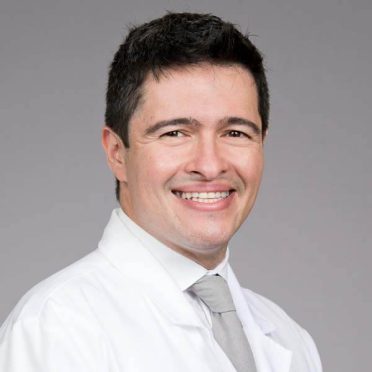Leatha Crook is walking again.
Her life is not yet as it was — she wears special glasses now, she needs a cane, her arms and legs are weaker, she’s no longer working — but the 57-year-old has come a long way from where she was last December.
“I went out shopping with a friend, and when I got home and was stepping out of the car, it hit me. I couldn’t move. If I were to have let go of the door, I would have fallen. I was stuck,” Crook said.
Crook’s friend rushed around to her side of the car and managed to sit her down. He asked her what he should do, and she had him take her to St. Vincent’s Medical Center’s Emergency Room.
“I wasn’t feeling pain, but I was so nauseous,” she said. “I ended up puking and then my head started pounding, like a hammer was hitting it. I could move my arms but not my legs. I couldn’t walk. I lost my balance to the point where everything was weak.”
> Sign up for the annual stroke symposium at St. Vincent’s Medical Center
The former custodian had suffered a stroke, a common problem in the United States, according to Daniel Cavalcanti, MD, PhD, a neurosurgeon at St. Vincent’s Medical Center’s Ayer Neuroscience Institute. Every 40 seconds there is a new stroke in the United States, which adds up to 800,000 strokes a year, he said.
“Stroke is the leading cause of long-term disability,” Cavalcanti warned, citing the two main types of stroke. The most common is ischemic stroke, which is characterized by a lack of good blood flow to the brain and causes cell death. A hemorrhagic stroke means there is bleeding in the brain. Both share similar risk factors and outcomes but require different treatments.
“For ischemic stroke, there are two main treatments,” Cavalcanti said. “We can give medication that helps break down clots if they show up quickly in the emergency room. The drug dissolves the clots and brings normal blood flow to the vessels if given within 4.5 hours of the first symptoms.”
The other treatment is slightly more invasive. Through a mechanical thrombectomy, doctors make a small incision in the groin area and take catheters from there through the blood vessels all the way up to the clot in the brain or neck. They then create negative pressure through the tubes to suck out the clots. It’s all about getting blood back to the brain as soon as possible.
“Some patients can tolerate lack of blood flow for hours, but others can’t go even minutes,” Cavalcanti said. “Basically we have a 24-hour window to do this procedure from onset of symptoms, but the sooner the better. It’s unpredictable how patients will do without that blood flow.”
And that’s just the emergent care. Oftentimes strokes require long-term assessment and rehabilitation, like in Crook’s case.
“It was hard because I was in the hospital for a whole month,” she said. “They monitored me in the ICU for a long time, then rehab for two weeks where they helped me walk again. I was bedridden. They were cleaning me after I went to the bathroom.”
> Want more health news? Text StartHere to 85209 to sign up for text alerts
When someone has a stroke, the part of the brain that has lost blood flow can be permanently damaged, which is why getting to a hospital immediately is so important.
“If we can restore blood flow to that part of the brain, we can quicken recovery,” said Kelly Matmati, MD, the chair of neurology and director of the Stroke Program at St. Vincent’s. “Once in the recovery stage, you may have lasting damage in the brain from the stroke, so what we have to do is train the healthy part of the brain to take over the function of the part of the brain that was damaged. So people who might have been completely paralyzed may be walking six months or a year later. The damaged area doesn’t restore itself; there is a scar there, but the patient recovers.”
Matmati says mental health rehabilitation is just as important as physical rehab.
“If someone has depression after a stroke, which is fairly common, it’s important that we treat that because depression can hinder recovery,” she said. “We will work with the primary care doctor to determine a regimen, including therapy, counseling and medicine.”
Crook experienced this throughout her long recovery.
“One day I just broke down. I was just crying because of all the things that happened to me,” she said, adding that the hospital staff helped her through. “You get nasty, you get frustrated. You don’t want to be bothered, but they were really patient with me, and I thank them for that.”
She said the team at St. Vincent’s was consistent and caring during her entire stay.
“The doctors and nurses in the hospital were amazing. They kept checking on me, smiling at me, joking with me. They let me know that everything would be fine, everything would be OK,” she said. “Even my case manager talked with me and said it’s OK to cry ― it doesn’t make you weak.”
That journey back to hope is one of the reasons Matmati specializes in this type of care.
“I got into stroke neurology because of the potential to help patients both in the acute period and also the recovery period, improve their lives, and get them back to their families,” she said. “I think it’s important to bring hope to people, because stroke can be very devastating and people can get discouraged. People overestimate the negative effects that disability might have on their life.”
Keep in mind, no stroke is the same. From the risk factors to the mechanisms at work during and after the event to the recovery, every person’s journey is different.
Cardiac disease, smoking, high cholesterol, high blood sugar, atrial fibrillation, obesity and lack of exercise all increase the risk of a stroke, but one of the largest factors is uncontrolled high blood pressure.
“To prevent a stroke, have a healthier lifestyle,” Cavalcanti said. “Stop smoking ― that’s a main risk factor. Control your blood pressure, your body weight, engage in a healthy diet and try to control your cholesterol.”
The important thing for any stroke is to get to the hospital immediately and to understand it’s not the end. For many it will pass and things will get better.
“If you talk to someone who has never had a stroke and asked them what they think would happen, they might say, ‘oh, it would devastate me,’ but if you talk to someone who has had a stroke, many times you’ll find they are thriving and happy,” Matmati said. “They’ve found a way.”
Crook too has found a way.
“I was determined to get better, and I was determined to do it myself. You have to have that vision to improve,” she said. “I just did what I had to do for me to get out of this predicament and get better.”




